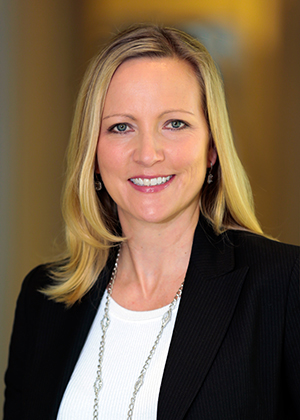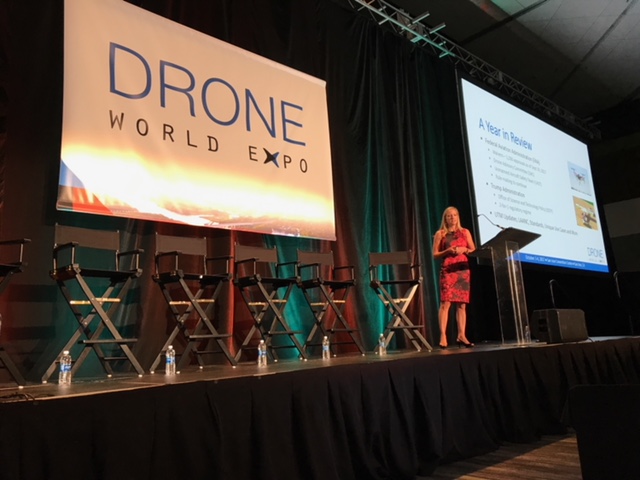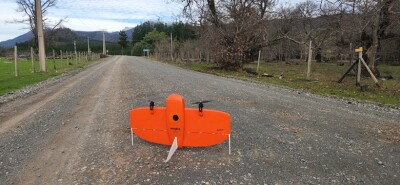With a dedication to reducing the barriers around how drones can be utilized for commercial purposes as well as providing education about the benefits of UAV technology, the Commercial Drone Alliance has been able to move the industry forward in very real ways. Their development of the Drone Security Summit series, proactive work on the Remote ID and Tracking ARC, development of robust legislative priorities for the commercial drone industry, calls for Congress to repeal Section 336 as well as the conference program they created for Drone World Expo are just a few examples of how they’re driving the industry forward.
Now that Drone World Expo
has come together with Commercial UAV Expo to create the largest commercial drone event in the market, the Alliance’s efforts to deliver top-notch conference content have been taken to another level. They’ve helped put together an
advisory board that is a veritable who’s who in the drone industry to provide the most relevant, actionable information available.

Gretchen West
As the co-chair of the Commercial UAV Expo advisory board,
Gretchen West is currently working with organizations that range from Intel to AT&T to Facebook to BP to create a conference program that showcases what it means to utilize drones to perform a variety of tasks faster, cheaper and safer. As Senior Advisor at Hogan Lovells US LLP in their Global Unmanned Aircraft Systems practice group, Co-executive Director of the Commercial Drone Alliance and Founding Member,
Women of Commercial Drones, it’s something she is uniquely qualified to do. We connected with Gretchen to talk through how things are shaping up for the event, but to also discuss her insights related to the business development endeavors of the Commercial Drone Alliance.
To read an interview with Co-Executive Director Lisa Ellman that is more focused on the regulatory efforts of the Alliance,
click here. Jeremiah Karpowicz: A lot has changed in the industry since you sat down with Ian Smith for an episode of the Commercial Drones FM podcast, but the topics you discussed related to opportunities and consolidation are as relevant as ever. Have you been surprised by any of the recent happenings in these areas?Gretchen West: I haven't necessarily been surprised, but I've seen a lot of positive developments that show a natural business evolution that is now evident in our industry. I still think many people see opportunity in the drone market and are working to come up with unique solutions for some of the challenges this industry faces. Many are joining this space because they believe they can make an impact.
At the same time, we are starting to see more consolidation. We’ve seen companies succeed and fail, and we'll see more and more activity as the industry matures and companies actually start turning a profit and the regulatory issues soften.
Regarding those people that are coming up with these ideas, is that more often about hardware or software? Are those ideas impacting end users and service providers in different or similar ways? Obviously, DJI controls the majority of the market share, which makes it difficult for new entrants. From a hardware perspective it's a challenge, but there are some companies that are developing some interesting hardware solutions that could solve some of the challenges our industry faces. However, I think the real opportunities are in software development and data analytics.
That said, the most powerful ideas come from getting the drone industry engaged with the end user industry to find out exactly what they need. It's not about the drone, it's about the data collected and how it's provided to end users to make quick and efficient decisions. I think there's still great opportunity in bridging the gap between collecting data and providing a valuable solution to the end user, but the industry needs to work harder to understand what the end user needs.
We hear from end users quite often that they're getting pitched services from companies that know drones, but those companies don't necessarily know the type of data the end users actually need. Regardless of the industry you’re working in, you must understand what the end user needs so you can provide them with the right information. That's where you gain a competitive edge.
One of the most powerful things you mentioned on that episode was your focus on helping the drone industry succeed by helping users succeed, and doing so is about removing barriers. Are these barriers more often about technology, regulation, or business strategy? It's definitely a combination of all those things. The regulatory barrier is the one most people talk about, and it still exists. In certain industries, Part 107 enabled the types of operations they needed, but there are other industries where they really need to operate at night or fly over people or BVLOS, and those operations are restricted by Part 107.
Another barrier we deal with is related to public perception of the technology Drones still get a bad rap in the press and general public, so if you’re (for example) a large oil & gas company looking to adopt a drone program that is going to monitor your pipelines or flare stacks, the regulatory burden is not the only one, there is still public concern about the use of drones which presents a public perception challenge. The use case as far as how the technology can perform those tasks faster or more safely is evident, but they also need to address any concern from the public over what data is being collected, where they're flown, and how doing so impacts privacy issues.
Getting past these barriers all comes back to the technology, and that means proving that this technology can collect and process the right data to give them the answer they need and operate safely and reliably.
That regulatory barrier to entry is definitely one people are still talking about, and there’s a whole new discussion around it in the context of the Alliance’s call for Congress to repeal Section 336. What’s ultimately driving your position around this issue?Section 336 was written several years ago, and the technology has changed dramatically since then. When you look at the statistics around how many drones have been registered, there are over a million drones that are recreational-focused, and roughly 800,000 of those do not fall under a community-based organization, which has caused concern across the Federal Government.
Repealing or amending or changing 336 is not meant to burden the hobbyist community, but instead to help the drone industry at large grow. Ultimately, registration is a mechanism for holding people accountable in case of an incident, but the bigger issue is around Remote Identification. It’s something that policy-makers talk about in terms of the “criminal, the careless and the clueless."
“Criminal” is a category that security agencies are obviously very concerned with, but a lot of the mishaps and the near misses that we see fall into the “clueless” and “careless” categories. Someone might be flying near an airport because they don't know the rules. We've all seen the videos of incidents like when the drone almost hit
a skier. That's why security agencies are concerned about all drones flying in the airspace, because how do you know who's authorized or not authorized to be flying near critical infrastructure? You don't. How can you identify an operator near a stadium? You can't. You don't know which of those three categories people fall into. That's why remote ID is critical for the industry at large to move forward. I don't think we'll see rules that allow for broad operations over people or even BVLOS until this issue of Remote ID and tracking is solved and a solution is created. As currently written, Section 336 does not allow the FAA to regulate recreational users, and therefore under current law the FAA’s hands are tied and the agency may not mandate remote identification for hobbyists. For the Commercial Drone Alliance, again, we are not asking for heavy burdens on the hobbyist community, we are asking for a change to Section 336 to allow the FAA to regulate all users of the airspace to maintain a high level of safety and security. We understand there are different categories of drone operators, and they ought to be treated differently. But it should be up to the FAA to decide how that framework would look.
We’ll obviously be keeping a close eye on what happens with Section 336, but do you think end users are too focused on what can or will happen with such regulatory developments? Perhaps at the expense of what can be accomplished with the technology right now? We’ve seen a bit of a shift in that regard because I think in the beginning and right after Part 107 became official, there was pushback from some of the end users because of the limited scope of how they could operate under Part 107. I think some of them had this "all or nothing" approach. Now though, end users are seeing that if you're serious about the technology, there's a lot you can do under Part 107.
For anyone focused on BVLOS operations, there’s a way to complete a mission over a long distance under Part 107 with specific waiver approvals from the FAA. There are ways to utilize the autonomous capabilities of drones while still having a human operator involved. Many end users are starting to see that this is a process, but they're building towards a future where they will operate autonomously, BVLOS and over people.
It's baby steps, and I think most end users are seeing the value in taking these baby steps. You start small with what's available and allowed right now so you can build on that program and get the experience. Then, once these expanded operations are more broadly authorized, they'll be ready. They'll understand the drone market that much better and they'll be ready.
That understanding of the market and the technology is something Dyan Gibbens, one of the founding members of the Women of Commercial Drones forum, has showcased in powerful ways. Is that kind of insight something you wanted the group to be able to highlight not only for other women but to the drone industry as a whole? Dyan is incredible and tireless. She's so passionate about this technology, and a lot of that passion comes from her interest in STEM (Science Technology Engineering and Mathematics). She spends a lot of time working with younger generations to get them interested in this technology so that they can have some of the same opportunities that she has had. While STEM includes both boys and girls, she also has a strong passion to help women in this industry succeed.
There are a lot of women in this space, and more and more are joining us every day which is really exciting. There are informal things that we do as a group, but a lot of it is just working with other women, and encouraging them to join this community and mentoring them along the way. There are lots of stories I hear from women who have gone to an AMA field and felt shunned or don't feel like they get hired for a job because they're a woman, and I think we're seeing more and more women taking stronger leadership roles in this community. That’s something we want to be able to encourage and support.
Additionally, there are so many conferences, and we've continued to push for women to be included in all of those conversations. There's a tremendous amount of intelligent women that are in this industry who are helping to see it succeed, and we need to be able to showcase them and hear more from them.
Enabling those kinds of conversations is something you’ve done in the context of the conference program for Drone World Expo, and will now be doing at the Commercial UAV Expo. What can you tell us about industry events like these that are solely focused on the commercial application of drone technology? There are lots of other events out there, and some of them cater to multiple industries, multiple audiences which can make it difficult to get the right information you need. That's the beauty of the Commercial UAV Expo, because it's so laser-focused on the commercial drone segment of this market which is really critical.
As we discussed in the context of Section 336, there are so many different types of users of the national airspace system, and you can't have the same message for everyone. So the focus for us is on how to create value for end users. What are the issues people need to understand? Who are the experts people need to hear from? The event is meant to provide the tools and the information commercial end users need to walk away from an event and be successful, and that’s what makes it unique.
As the co-chair of the Commercial UAV Expo Advisory Board, you’re working with some of the biggest names in the space to come up with the conference program for the event. How important is it to be able to work with stakeholders from Facebook, Intel, AT&T, CNN and plenty more to create a conference program that resonates with commercial enterprise end users?For the longest time, a lot of these big name companies weren't in the drone space at all. Who would have thought a few years ago that Intel would be a leader in this space? Who would have thought CNN would be a leader in this space? Now there's brand recognition from these major companies that are really investing in the drone community because they see the value of using drones in a variety of different ways.
As an example of that, I was at a security conference recently and moderated a panel with JP Morgan Chase where they announced a partnership with a company that provides physical security drones, for perimeter security. JP Morgan Chase believes they are the first financial institution that will be using drones to protect their numerous facilities and their data for their customers
That's just another example of the types of companies that are getting involved in this space, because you don't normally put JP Morgan Chase and drones in the same sentence. It's amazing to see how many different industries are buying into the technology. They're seeing the value, and that’s something we’ll be able to highlight at the event.
That really underscores the importance of understanding how to make the technology make sense today because it’s something that can impact the future just as much as the present, doesn’t it? Yes, but what’s really interesting to think about is how fast it can happen. Drone technology has been around for decades, but it went from something quiet to something huge very quickly. That’s why making people aware of these topics early so they can adapt their own business models to accommodate the future of this technology is really important. This is something I think the Commercial UAV Expo will be able to do by helping people understand what's coming in the next 5, 10 or even 20 years.
Some skepticism still exists from some end users, but I think they're all starting to see more value, and developments like the one with JP Morgan Chase announcing their introduction into the drone space helps others see that there is value in using drones as a tool. I believe we will get to some of the numbers that are in all of those varying forecasts. It will just take some time.
















Comments